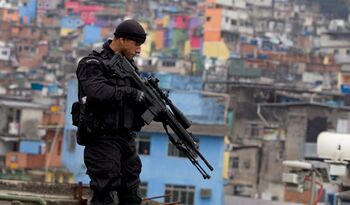Departémente Sécurité Internal
| Departémente Sécurité Internal | |
 | |
| Federal Investigations & Law Enforcement overview | |
|---|---|
| Formed | 1969 |
| Jurisdiction | Inyurstan territory, with some minor abroad activity |
| Headquarters | 16 Roucharde Avenue, Castille de Térro, Inyursta |
| Employees | >100,000 |
| Ministers responsible |
|
| Federal Investigations & Law Enforcement executive |
|
The Departémente Sécurité Internal, better known as the ISD, is a federal-level law enforcement and civilian intelligence agency operating all across Inyursta. It operates directly under the supervision of the federal government, and is not limited by provencial or local jurisdiction concerns. This agency has been the subject of both controversy and admiration due to their heavy-handed tactics.
History
The ISD was formed in 1969 alongside the creation of La Républiqua D'Inyursta after the conclusion of the Inyurstan Civil War. It was intended as an internal agency to focus on domestic intelligence and counter-espionage, while the military intelligence agency NIS was made to focus on external and foreign operations.
ISD units were involved heavily with the Inyurstan National Guard during the Red Insurgency, to help locate leftist holdout cells and suppliers of insurgents. This agency was also the primary source of signals intelligence and other sources of recon used when tracking down drug lords such as Pedro Esteban Petain and the Drake Brothers
Personnel
The ISD employs a wide number of personnel of varying kinds, from basic source analysts to specialized SWAT forces and administrative staff. Employees of the ISD are officially considered to be civilians by the Inyurstan government, however benefits offered by the agency are similar in nature to those offered to military servicemen. Additionally, in special cases such as Captain Javier Chapelle who was killed in Operation: Blue Fang and Agent Leonardo Tançias killed during the Whistleblower Crisis, ISD personel can be buried with full military honors.
Operators
Operators are considered the "foot soldiers" of the ISD, and function like a large national SWAT team. They are the units responsible for apprehension of some of Inyursta's most wanted criminals, from big time money scammers and con artists to well-connected and armed narco-traffickers.
The operators are the most well armed and equipped branch of the ISD, and alongside the UCNÉ the most well armed law enforcement agency in the country. ISD operators utilize armored vehicles such as MRAP's, armored swat vans, helicopters such as the MH-70 Nacanina and UH-1N. Small arms include IMBEL MD-97 series and M4 carbines, as well as a variety of pistols.
Command structure in the operator branch consists of six ranks, Opérator Basico (Operator Basic), Opérator Premiéro (Operator 1st Class) Opérator Seníor (Senior Operator), Opérator Chief (Chief Operator), Lieutenant, and Captain. Operator teams often answer up to an organic officer such as a Lieutenant or Captain, but can also be assigned under the direct authority of a Special Agent or Chief Agent depending on the mission.
Analysts
Analysts are the "information workhorses" of the ISD. They work tirelessly shifting through files, records and other sources of electronic information in addition to evidence taken by Agents. The main job of an ISD analyst is to obtain, verify, compile and present relevent information to their superiors which can then be used accordingly.
This position is more of a "desk job" and a given ISD analyst will probably never see a direct operation or crime scene investigation throughout their term as such (granted some may be promoted to agent). Analyst positions are covered by four ranks Analiste Basico (Analyst Basic), Analiste Premiéro (Analyst 1st Class) Analiste Seníor (Senior Analyst), Analiste Chief (Chief Analyst), and they almost always answer directly to an agent or administrative officer.
Agents
Agents are essentially the "multirole experts" of the ISD. To become an agent, one must be trained in a variety of skills, including leadership, investigations procedures and tactical performance. By nature, an agent is expected to be able to perform an equally diverse set of tasks in the field, including but not limited to crime scene investigations, HUMINT intelligence gathering, arrests & takedowns as well as event security and surveillance.
Despite active agents making up less than 4% of the total workforce of the ISD, they are considered the "faces" of the department - mostly due to their involvement with questioning individuals, public relations and the aura of secrecy and "spook"-like nature of their work.
This branch consists of three ranks: Agenté (Agent), Agenté Éspecial (Special Agent) and Agenté Chief (Chief Agent). ISD agents are placed in either independent roles or in charge of a team, often consisting of operators, analysts or both.
Others
The ISD is staffed with a wide variety of less numerous but diverse positions besides the main three listed above. Other personnel positions include but are not limited to administration & command, public relations, medical staff, toxicologists, morticians, pilots & technicians, ect.
Operations
The Departémente Sécurité Internal is predominantly tasked with domestic operations, including major or pan-provencial crimes, counter-narcotics, anti-terrorism as well as the protection of high-risk individuals including some politicians or public figures and those in witness protection. Because of the overlap in the field of counter-narcotics, the ISD does share a mostly friendly rivalry with the national police unit UCNÉ.
Cases of foreign operations are rare, but not unheard of. Incidents were Inyurstan nationals are killed or kidnapped abroad, such as the Rando Sourez Murder Investigation, are the most likely to facilitate an ISD overseas operation. Because the NIS is constitutionally barred from arresting Inyurstan citizens, the ISD is often tasked with the job of arresting fugitives or dangerous criminals of Inyurstan nationality abroad, such as Operation: Whiskey Sunrise, where a high-ranking member of the Ochaca Cartel was arrested in Miami.

Criticisms
As an organization, the ISD has been subject to a number of criticisms, mainly revolving around its information collection and its law enforcement methods. Operators are most heavily criticized for their alleged brutality, as suspects are often severely bruised or injured upon arrest, and in some instances killed. The information collection branch has been labelled as a domestic spying agency for its surveillance and occasional incidents of warrantless wire taps - mostly against well-connected cartel associates. Other critics of the ISD point to the well-equipped nature of ISD operations, including armored vehicles, assault rifles and ELINT/SIGINT aircraft as evidence the organization is "excessively militarized" for a civilian law enforcement agency.
During the Whistleblower Crisis, the ISD was accused of providing support to CADI as justification for the arrest of Agent Henri Melendez and Agent Leonardo Tançias. The leftist tabloid journal The Daily Worker accused the ISD of being a state-sanctioned hit squad used to arrest and murder the enemies of then-Président Jack Peresque.